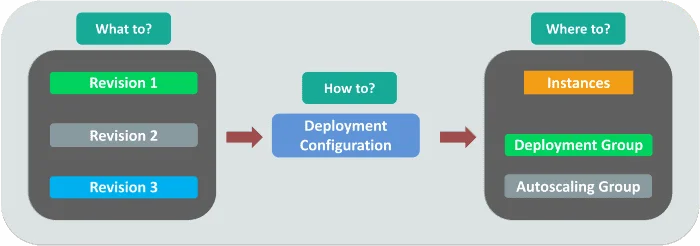Blog
AWS CodeDeploy – Automating Deployment of Applications
The process of application building can be split into three parts. Writing the code, testing it, and seamlessly deploying it. But this theory is only limited to the papers. Manual deployment often results in errors and downtime of your application. What if the deployment process can be automated? Yes, AWS has come up with CodeDeploy to automate this process. With SNDK Corp Solutions, you can easily release new features and updates with a few clicks.
What is AWS CodeDeploy?
AWS CodeDeploy is a deployment service that automates the deployment of your application on various AWS resources. The automated deployment provides you with an edge over manual deployment as it minimizes the errors. It helps you release new features with ease. Your application is always updated, and the complexity is all handled by AWS CodeDeploy. Here we enlist the content that can be deployed and where it can be deployed as per SNDK Corp.

Content that can be deployed are-
- Code and AWS Lambda functions.
- Web applications and configuration files.
- Scripts and executable files.
- Packages and multimedia files.
The platforms where it can be deployed are-
- Amazon EC2
- AWS Fargate,
- AWS Lambda
- On-premises Servers
Benefits of AWS CodeDeploy
Let us have a look at the wide range of benefits it offers-
-
Automated Deployments
The core essence of this service is automation. It frees the developers from the hassle of the complex processes of Deployment. Moreover, it scales itself with the infrastructure of your application. Manual deployments are prone to errors. It might be that all your efforts go in vain and you don’t get the desired result after deployment. AWS CodeDeploy saves you from these complications and deploys your application rapidly and reliably.
-
Reduction in Downtime
Suppose you have a running application and now you wish to add some new features to it. Naturally, it will be required to pause the application for maintenance. The time during which the application isn’t available for the users is termed as downtime. AWS CodeDeploy helps to minimize downtime and maximize the availability of applications to users.
-
Centralized Control
The power is in your hands. With AWS CodeDeploy, you can also check the track of your application. CodeDeploy provides you with a detailed report of when and where the versions of your application were deployed. You can even create push notifications to receive the live status of the application deployment. Alongside automation, AWS CodeDeploy also offers you the power so that you can have control over the deployment process.
-
Easy to understand
Whether the application is being deployed at Amazon EC2 or at AWS Lambda, the experience is the same. It is very flexible in working with different types of applications. Additionally, your current release of the software can be integrated with AWS CodeDeploy for continuous automation. Its flexibility and adaptability make it easy to understand. With SNDK Corp you can shift your application to Amazon Web Services for availing the aforesaid benefits of AWS CodeDeploy.

How does it work?
After going through the advantages of AWS CodeDeploy now let us dive into it’s working. How does it manage to automate the complex processes? We can divide the methodology into three parts. Have a look at the detailed explanation of all these stages as per SNDK Corp.

-
Application-
The application means the code that needs to be deployed. It can be source codes or revision files uploaded on a Github repository or an AWS S3 bucket. Revision files are different versions of your application.
-
AppSpec File-
It is a simple configuration file with the extension .yml. Also, it is a blueprint of your deployment process. Moreover, it contains the details of your version, the source files, and the destination environment.
-
Deployment Group-
The set of instances that are associated with the deployment process comprises the deployment group. This is basically where we need to deploy our application.
Use Cases
- A large Number of Deployments- In case of large number deployments a day, AWS CodeDeploy can come to our rescue. With continuous automated deployment and reduction in downtime, this service can prove to be a boon for the developers.
- Multiple features deployment- CodeDeploy is used by SmartNews to support a software delivery pipeline consisting of a number of microservices such as a news crawler, image analysis engine, and content creator. In other cases where there are a number of features to be deployed, AWS CodeDeploy can be used to automate the process and integrate all the microservices.
Also, Read the Previous Post
5 Things to know about AWS CloudFront
Conclusion
In a nutshell, cases where large scale deployments are necessary for a live application, AWS CodeDeploy can be used. The reduction in downtime is an added bonus to its uses. Even for small scale applications, CodeDeploy can scale itself according to the resources. Although the process is automated, still we can have control over the process and terminate it anytime. Overall, AWS CodeDeploy is a must-have service for your application.
